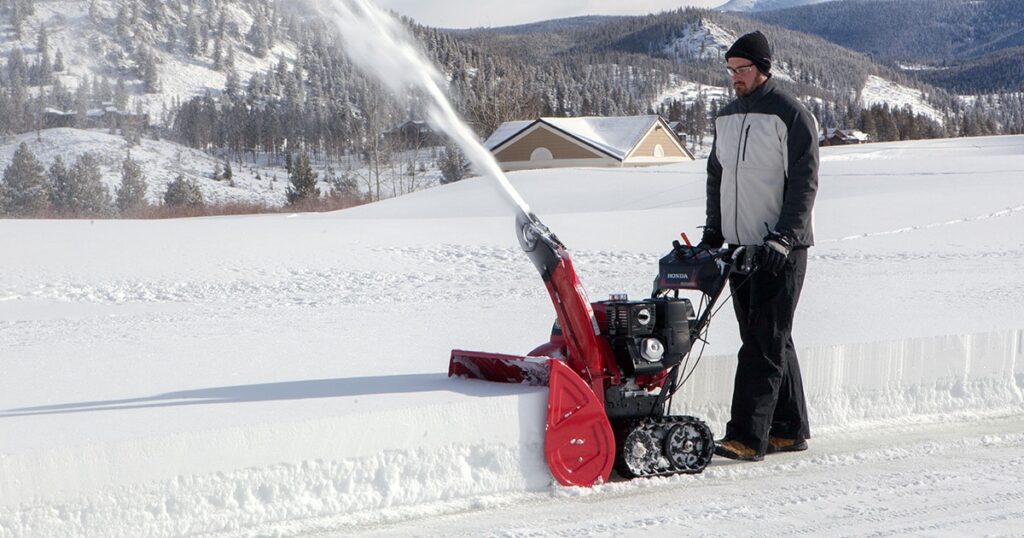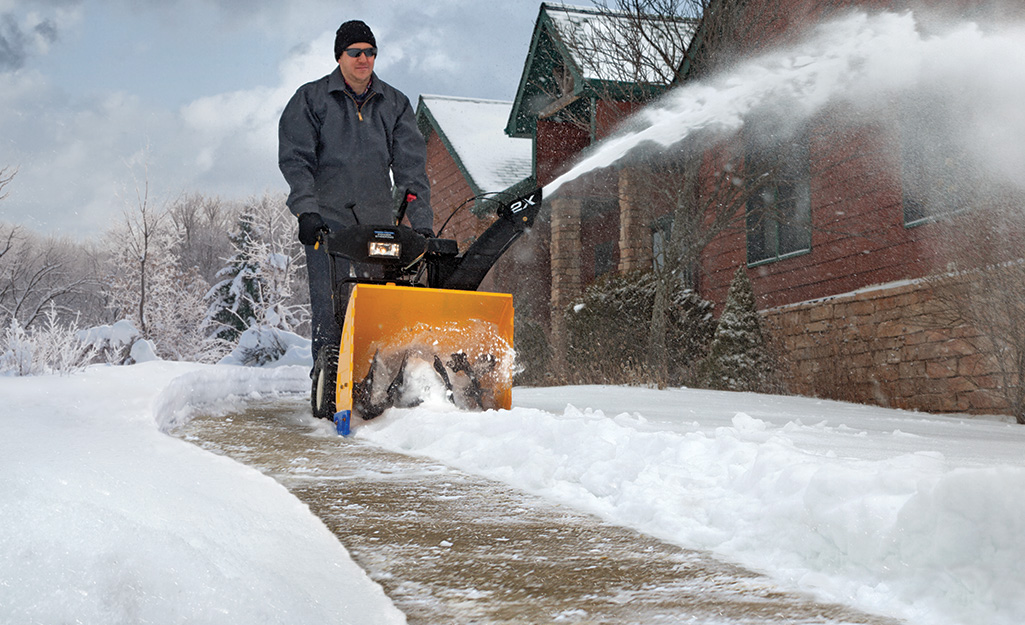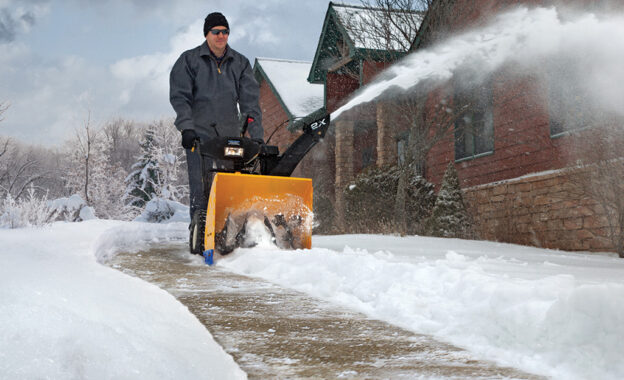So, you’re gearing up for a snowy winter season and you’ve got your trusty snowblower ready to go. But before you head out to battle the piles of snow, you might be wondering just how deep of a snowfall your snowblower can handle. After all, you don’t want to find yourself stuck in a literal snowstorm, struggling with a machine that’s overwhelmed. In this article, we’ll explore just how deep of snow a snowblower can handle, providing you with some valuable insights to make your winter snow removal a breeze.
Factors that influence the snow depth a snowblower can handle
When it comes to using a snowblower, one of the most important things to consider is the depth of the snow that it can handle. There are several factors that can influence the maximum snow depth a snowblower can handle, including the type of snowblower, the size and power of the snowblower, the type of snow, the terrain and surface conditions, and the environmental factors.
Type of snowblower
The type of snowblower you choose can have a significant impact on the snow depth it can handle. There are three main types of snowblowers: single-stage, two-stage, and three-stage.
Single-stage snowblower
A single-stage snowblower is generally best suited for light and fluffy snowfalls. It uses an auger to gather the snow and propel it out of the chute. These snowblowers are typically smaller and less powerful, making them ideal for clearing smaller driveways and sidewalks.
Two-stage snowblower
A two-stage snowblower is more powerful than a single-stage snowblower and can handle deeper snow. It uses an auger to gather the snow and a separate impeller to propel it out of the chute. The auger breaks up the snow and feeds it to the impeller, making it more effective at handling wet and heavy snow.
Three-stage snowblower
The most powerful type of snowblower is the three-stage snowblower. It features an auger to gather the snow, an accelerator to break it up further, and an impeller to propel it out of the chute. These snowblowers are designed for heavy-duty snow removal and can handle the deepest snowfalls.
Size and power of the snowblower
Another important factor to consider is the size and power of the snowblower. The size of a snowblower is typically determined by its engine displacement, which is measured in cubic centimeters (cc). A larger engine displacement generally indicates a more powerful snowblower that can handle deeper snow.
Engine displacement
The engine displacement of a snowblower plays a crucial role in its capability to handle deep snow. Snowblowers with larger engine displacements, such as 250cc or higher, are generally better equipped to handle deeper snow. However, it’s important to choose an engine displacement that aligns with your specific snow removal needs.
Clearing width
The clearing width of a snowblower refers to the width of the path it can clear with each pass. Snowblowers with wider clearing widths generally have a greater capacity to handle deeper snow. For example, a snowblower with a clearing width of 28 inches can handle deeper snow compared to one with a clearing width of only 20 inches.
Clearing depth
In addition to the clearing width, the clearing depth of a snowblower is also an important consideration. Snowblowers with larger clearing depths can handle deeper snow more effectively. It’s recommended to choose a snowblower with a clearing depth that matches the average snow depth in your area.
Ampere rating
The ampere rating of a snowblower’s motor can also impact its ability to handle deep snow. A higher ampere rating generally indicates a more powerful motor that can handle heavier and deeper snow. Checking the ampere rating can help ensure that the snowblower is equipped to handle the snow depth you anticipate.
Type of snow
The type of snow you’re dealing with is another critical factor in determining the snow depth a snowblower can handle. Different types of snow require different levels of power and clearing techniques.
Light and fluffy snow
Light and fluffy snow is typically the easiest type of snow for a snowblower to handle. Both single-stage and two-stage snowblowers can effectively clear light and fluffy snow without much trouble. However, it’s important to note that the snow depth can still impact the efficiency and speed of the snowblower.
Wet and heavy snow
Wet and heavy snow can pose a greater challenge for snowblowers. Single-stage snowblowers may struggle to clear wet and heavy snow effectively, while two-stage and three-stage snowblowers are better equipped to handle the extra weight. The power and torque provided by these snowblowers enable them to handle wet and heavy snow more efficiently.
Packed or icy snow
Packed or icy snow can be particularly challenging to clear, as it requires more power and force to break up and remove. Two-stage and three-stage snowblowers are better suited for clearing packed or icy snow due to their auger and impeller systems, which can effectively break up and remove these types of snow.
Slush or mixed precipitation
Slush or mixed precipitation, such as a combination of snow and rain, can create challenging conditions for a snowblower. While single-stage snowblowers can handle slushy conditions to some extent, two-stage and three-stage snowblowers are generally more effective at handling slush due to their enhanced power and clearing capabilities.
Terrain and surface conditions
The terrain and surface conditions on which you’ll be using the snowblower can have a significant impact on the snow depth it can handle.
Flat and even surfaces
If you’ll primarily be using the snowblower on flat and even surfaces like driveways or sidewalks, you’ll have more flexibility when it comes to the snow depth. Most snowblowers, even single-stage ones, can handle moderate snow depths of 6 to 8 inches on flat surfaces without much difficulty.
Inclines and slopes
Inclines and slopes present additional challenges for snowblower operation, especially when dealing with deep snow. The added incline can make it more difficult for the snowblower to effectively clear the snow and propel it out of the chute. In such cases, it may be necessary to make several passes to remove the snow completely.
Uneven or bumpy terrain
Uneven or bumpy terrain can also affect the snowblower’s ability to handle deep snow. It may be more challenging for the snowblower to maintain traction and maneuverability on rough surfaces, which can impact its overall performance. Clearing deep snow on uneven terrain may require more effort and time.
Gravel or uneven surfaces
If you have gravel or uneven surfaces in your snow removal area, it’s important to choose a snowblower with adjustable skid shoes. Adjustable skid shoes allow you to raise the auger off the ground slightly, preventing it from picking up gravel or damaging the surface. When clearing gravel or uneven surfaces, it’s recommended to adjust the snowblower height accordingly to avoid potential damage.
Environmental factors
Various environmental factors can also influence the snow depth a snowblower can handle.
Temperature
Extreme temperatures, whether extremely cold or warm, can impact the performance of a snowblower. Extremely cold temperatures can cause the snow to freeze and become harder to remove, while warmer temperatures can lead to wetter and heavier snow. Snowblowers with higher power ratings and efficient snow handling mechanisms are better equipped to handle extreme temperatures and the associated snow conditions.
Humidity
Humidity levels can impact the consistency of the snow, making it lighter or heavier. Higher humidity levels can result in heavy and wet snow, which may require a more powerful snowblower to effectively clear. Lower humidity levels often produce lighter and fluffier snow, which is generally easier for most snowblowers to handle.
Wind speed
Wind speed can significantly impact snow depth by causing drifts and accumulations in certain areas. Snowblowers may face difficulties when clearing drifted snow, as the depth can be unpredictable and uneven. In cases of high wind speeds and drifting snow, additional caution and multiple passes may be necessary to ensure thorough clearing.
Snow density
The density of the snow, which refers to the weight of the snow in a given area, can also affect the snow depth. Heavy, dense snow requires more power to remove compared to lighter, fluffier snow. Snowblowers with higher horsepower or a three-stage mechanism are generally better suited for clearing dense snow effectively.

This image is property of www.snowblowersdirect.com.
Maximum snow depth for different snowblower types
The maximum snow depth that a snowblower can handle varies depending on the type of snowblower.
Single-stage snowblower
Single-stage snowblowers can typically handle snow depths of up to 8 to 12 inches, depending on the power and size of the machine. However, it’s important to consider the type of snow and other environmental factors, as these can impact the snowblower’s performance.
Two-stage snowblower
Two-stage snowblowers are more powerful and can handle deeper snow than single-stage snowblowers. On average, a two-stage snowblower can handle snow depths of up to 16 to 22 inches, depending on the specific snowblower’s size and power. However, the type of snow and other factors should still be taken into account.
Three-stage snowblower
Three-stage snowblowers are the most powerful and can handle the deepest snow. These snowblowers can typically handle snow depths of up to 20 to 30 inches or more, depending on the model’s specifications. Three-stage snowblowers are specifically designed for heavy-duty snow removal in areas that experience extreme winter conditions.

This image is property of contentgrid.homedepot-static.com.
Clearing strategies for deep snow
When faced with deep snow, certain clearing strategies can help optimize the snowblower’s performance and efficiency.
Multiple passes
In situations where the snow depth exceeds the snowblower’s recommended maximum, making multiple passes can be an effective approach. By making multiple passes over the same area, you can gradually clear the snow and prevent overexertion on the machine. This strategy may require extra time and effort but can help avoid straining the snowblower or causing potential damage.
Adjusting snowblower height
Adjusting the height of the snowblower can also be helpful when dealing with deep snow. Raising the height of the machine allows it to ride on top of the snow, preventing it from getting overloaded and becoming less effective. However, it’s important to find a balance, as setting the height too high may result in inadequate snow removal.
Clearing in layers
Clearing deep snow in layers can be a practical approach, especially if the snowblower struggles to handle the entire depth in a single pass. By dividing the snow into manageable layers, you can gradually remove it without overwhelming the machine. This technique may require multiple passes and adjustments to the clearing height, depending on the snowblower’s capabilities.
Using accessories or attachments
Certain accessories or attachments can enhance the snowblower’s performance when dealing with deep snow. For example, installing snow chains on the tires can improve traction in slippery conditions, allowing the snowblower to navigate and clear the snow more effectively. Additionally, using a skid shoe accessory can help protect the surface underneath and prevent the auger from picking up debris or damaging the snowblower.

This image is property of hgtvhome.sndimg.com.
Safety considerations when using a snowblower
While using a snowblower, it’s crucial to prioritize safety to prevent accidents and injuries. Here are some important safety considerations to keep in mind:
Reading the manufacturer’s guidelines
Before operating a snowblower, thoroughly read and understand the manufacturer’s guidelines and operating instructions. Familiarize yourself with the machine’s features, safety precautions, and recommended usage guidelines. Following these instructions will ensure safe and efficient snowblower operation.
Avoiding snowbanks or obstacles
When operating a snowblower, be aware of potential snowbanks, hidden obstacles, and debris in the snow. Snowbanks can contain hidden objects, such as rocks or branches, which can damage the snowblower or cause injury if they are picked up by the auger. Take care to avoid such obstacles and clear areas with hidden obstructions manually if necessary.
Wearing appropriate protective gear
Always wear appropriate protective gear when operating a snowblower. This includes goggles or safety glasses to protect your eyes from flying debris, ear protection to prevent hearing damage from the machine’s noise, and sturdy footwear with good traction to prevent slips or falls. It’s also advisable to wear warm clothing, gloves, and a hat to protect yourself from the cold.
Clearing snow during daylight or with ample lighting
Clearing snow during daylight or in well-lit areas is essential for maintaining visibility and preventing accidents. Adequate lighting ensures that you can see any potential obstacles or hazards in the snow, allowing you to operate the snowblower safely. If necessary, use additional lighting, such as portable floodlights or a headlamp, to improve visibility in darker areas.
Maintaining proper balance and stability
Maintaining proper balance and stability while operating a snowblower is crucial for your safety. Ensure that you have a firm and stable footing by wearing appropriate footwear and taking caution on slippery surfaces. Avoid overreaching or leaning too far while operating the machine, as this can destabilize your stance and increase the risk of falls or accidents.

This image is property of i.ytimg.com.
Conclusion
Understanding the limitations of a snowblower and considering various factors can help you determine the snow depth it can handle effectively. The type of snowblower, size and power, type of snow, terrain and surface conditions, and environmental factors all play a role in determining the snow depth a snowblower can handle. By choosing the right snowblower for your needs, following safety precautions, and properly maintaining the equipment, you can ensure efficient and safe snow removal during the winter season.

This image is property of contentgrid.homedepot-static.com.
